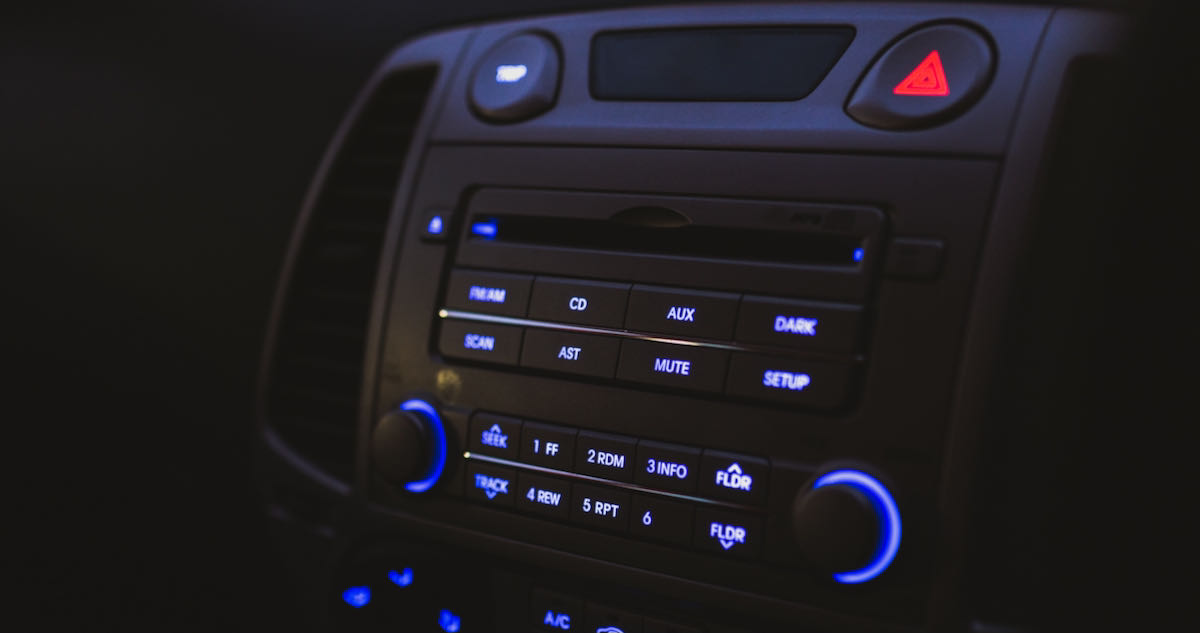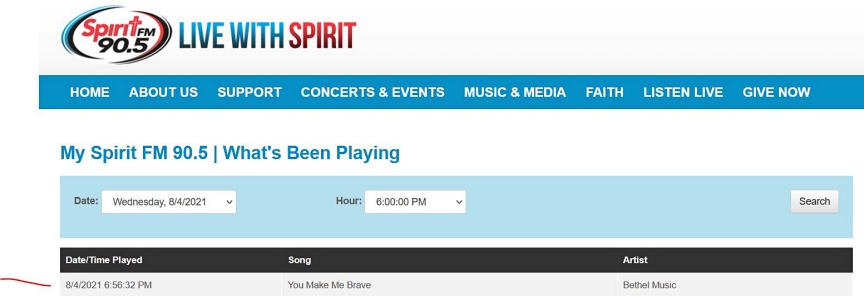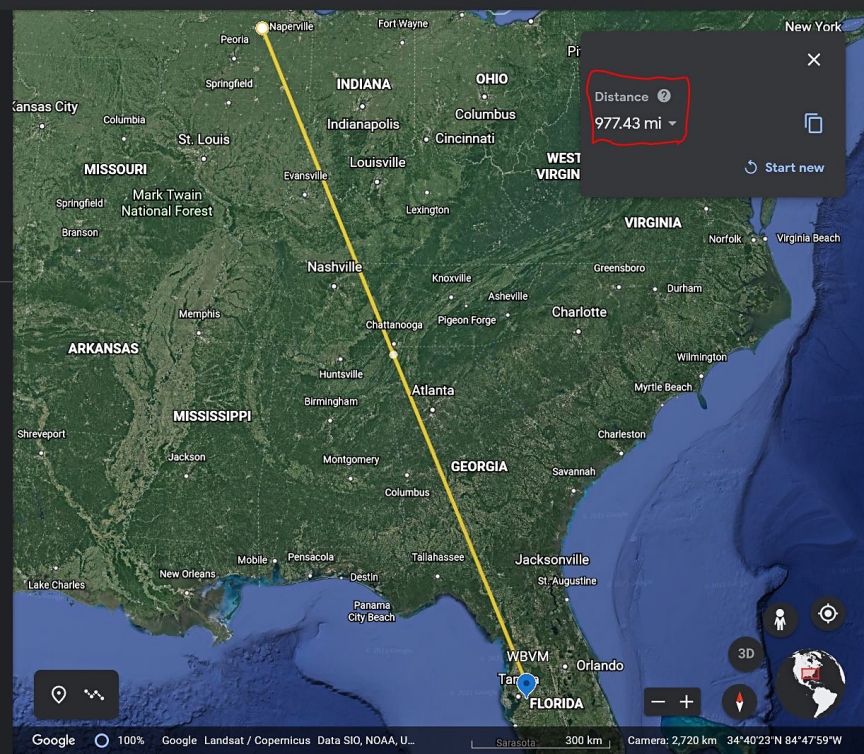Many thanks to SWLing Post contributor, TomL, who shares the following guest post:
Summer DX – Sporadic E, FM band
“Sporadic E” DXing is a specialty of some DXers. I have never dabbled in it being content with mediumwave or shortwave listening. However, it was truly fun to spontaneously hear this happen while driving on the Interstate highway, Wednesday August 4 around 6pm Central Time.
To quote from an ARRL propagation article:
“As frequency increases still further, signals will eventually pass through the F1 layer to the F2 layer. Because this is the highest reflecting layer, the distance spanned by signals reflecting from it is the greatest. The maximum skip distance for the E layer is about 2000 km. For the F2 layer that increases to about 4000 km—a significant gain.”
I was listening to the local classical music station WNIU in DeKalb, IL which is a good 50 kW transmitter about 10 miles behind me near the Interstate highway. A different station was breaking through. Eventually, I heard a familiar Christian song “You Make Me Brave” swamp the classical music. I noticed it was a remake of a song made about 10+ years earlier. The two signals fought it out and then I heard the station ID “Spirit FM” and a short humorous segment called “Attitude Adjustment”, then more music. Finally the local classical music station won out and I thought I would look up the station ID of that contentious station later.
When I googled “90.5 Spirit FM”, it came up with a station in Tampa Bay, FL called WBVM. Cool! Just to be sure, I went to the station web site and looked up their playlist and this confirms what I heard:
Curious about the transmitter, Radio Locator said it was a 100kW station and gave the Long/Lat coordinates. I then went to Google Earth and mapped an approximate distance of 977 miles (1572km), give or take 10 miles:
I did not have time to get on the shortwave radio to see if the 10 meter band was busy since I had things to do. But it is a very nice surprise to hear in my old car radio an FM station almost 1000 miles away. For one thing, Analog radio is still fun. Secondly, things are busy this summer if you are at the right frequency and time!
Happy Listening,
TomL




Thanks Alan, the only channels that I was able to pick up regularly were ABC Channels 0 from Wagga Wagga, Channel 2 Sydney and Hobart 2 and TVQ0 Toowoomba.
I recall an early morning opening in which the ABC appeared on Channels 0, 1 and 2 with channel 2 giving the strongest reception. As Australian channel 2 was NZ channel 3, I lost reception of channel 2 when our local station on channel 3 came on air.
I still remember the first time I experienced this. I was in Florida and found myself picking up a station from Oklahoma City with a cheap Walkman that I swear probably had some of the worst reception out of any radio I have ever owned. From that point I was hooked and days like that were like Christmas morning to me. Back in April I experienced my best sporadic event ever. From the Tampa Florida area I was able to pull KPRR from El Paso Texas on 102.1. Their transmitter is 1460 miles from me as the crow flies. I was using my Skywave and it lived up to its name.
When the band opens up I also recommend trying the NOAA weather frequencies. During the last few years I’ve heard weather radio from Indiana, Texas, and Arkansas.
Siimultaneously to the original logging, I was hearing two Salina, Kansas stations (Y93.7 and KHCD NPR 89.5) making it into the Washington-Baltimore metroplex. The charged particle cloud indeed was a very large size but very specific in the distant end landing zone….
It has been my experience that FM e skip happens often when a strong high pressure area is over head. Back in the day, analog TV dxing was fun too.
My first encounter with TV&FM DX was back in the mid 60s on a Sunday afternoon. As a 12 year old I didn’t realise it was a signal coming from Australia. Fast forward a few years. By then, I had discovered the DX hobby. ‘Alarm bells’ would ring whenever I spotted vertical lines crossing the TV screen that faded in and out it was a sign that the ABC (Australia) TV from Wagga Wagga, New South Wales, Australia was interfering with our local station in Wellington, New Zealand. If I was lucky changing channels would reveal the ABC from Sydney, NSW.
FM DX would have to wait for a few years because there was no FM stations in New Zealand at that time save for the occasional visiting pirate.
Moving to the present: (actually January 2020 and a move to Christchurch in the South Island of NZ) I was in the car traveling across town with the car radio tuned to 92.5. On that occasion there was a three way battle between Hokanui Radio in Ashburton a town about 70 KM South of Christchurch, RNZ Concert, Wellington in the North Island and to top it all off ABC News Radio, Tasmania, Australia. as each station faded in they were about the same strength.
Normally TV&FM DX is a summer activity but DX can occur during mid-winter. This winter I have kept my FM radio sitting on 95.7 which is the frequency of ABC Classics, Illawarra, NSW, Australia. One afternoon at the beginning of July (in the depths of winter here) they were heard for about 15 minutes along with other ABC stations using the same site. The local hams also had a fine time on the 6 metre band.
I am the section editor of the TV&FM page in the ‘New Zealand DX Times’ the magazine of the NZ Radio DX League (WWW.RadioDX.Com). The day before I had sent the July page to the Chief Editor. This resulted in an urgent message with news of the opening. He was just about to send the completed magazine to the printer but managed to squeeze this ‘hot of the press’ news in.
One thing that I have learnt over the years is that with any form of DX is to expect the unexpected.
Paul,
In 2007 Australia had the following channel 0 (45 – 52 MHz) transmitters;
RTQ MT MOWBULLAN Darling Downs Qld 300 kW effective radiated power reduced power toward Mt Ulandra. The transmitter was originally in Brisbane but was moved to the above site.
ABMN MT ULANDRA South West Slopes/Eastern Riverina which covers Wagga 200 kW Omnidirectional pattern. + 3 low power transmitters. For a while ATV in Melbourne was on channel 0 but was eventually moved to channel channel 10 and the transmitter was used by SBS for a while until it was moved to channel 28 which was the first high power UHF transmission.
NZ channel 1 was 44 – 51 MHz Sorry, I don’t have historical transmitter allocations.
Australian channel 1 (56 – 63 MHz) On the South Eastern “seaboard”
ABCN MT CANOBOLAS Central Tablelands 160 kW
ABAV MT BARANDUDA Upper Murray 160 kW and 8 others some very high powered
NZ TV channel 2 was 56 – 63 MHz
Australian channel 2 (63 – 70 MHz)
ABN Sydney, ABV Melbourne ABT Hobart, are all 200 kW each
CBN MT ULANDRA South West Slopes/Eastern Riverina which covers Wagga 200 kW Omnidirectional
22 others from low to high power.
NZ channel 3 (61 – 68 MHz)
Note that Australia had TV channel 3 85 – 92, channel 4 94 -91, channel 5 91 – 108 MHz which prevented the allocation of FM radio except for 92 – 94 MHz. Most of these transmitters were in areas adjacent to capital cities and were gradually moved to UHF finally completing it by 2012 when digital TV started.
I know of sporadic long distance reception in addition to transTasman, Sydney to Adelaide, Melbourne to Alice Springs, Darling Downs to Melbourne. Even an enthusiastic DXer in Perth WA receiving Japan as a once off. Yes, over the equator.
I’m not doubting you but where did you get that information?
It is very detailed and I would love to have access to such a source.
Thanks.
W4MKH
I haven’t had much luck with e-skip since I moved to the gulf coast (Alabama) but when I lived further inland it seems like every few years I’d hear something amazing on FM during the summer afternoons. Some of my highlights were hearing Albuquerque’s KZRR in HD from central Mississippi, then hearing it again a week later when I was actually *in* ABQ in person. Another was logging a French CBC station from Pell City, Alabama in the middle of a line of thunderstorms that stretched from southern Alabama all the way into Quebec.
A friend in North Alabama just logged Montana and South Dakota a few weeks ago; he’s also heard Mexico many times this year so far. Lucky!
One of my most memorable catches was sitting in the Beijing airport waiting for a connecting flight to Seattle and hearing Japanese FM stations in the 76-88MHz range on my CC Skywave SSB pocket radio! It was June and that was excellent E-skip.
That’s really short and over water: are you sure it wasn’t ducting?
What’s the minimum distance for e skip?
Like any other ionospheric refraction, it depends on the exact condition of the path at the time. In theory the LUF could become critical and you have a vertical return on 50 MHz. Has this ever actually happened? No idea.
Usually for Es the max distance for a single hop is specified which is around half to 2/3 (50-66%) of F2.
Now back to my comment on ducting: depending on what station you were listening to a path 100% over water (or nearly so) would be easy if conditions are right. Contacts are regularly made on 2m, 70cm, & 23cm between California & Hawaii, UK & Azores, and the east coast of Australia to the west coast of NZ via ducting. Methods to tell are the kind of fading and, if digital, the time stamps as bounces via the ionosphere should add quite a bit more delay, especially if multiple hops are involved.
Hope this helps!
It does, thanks!
Discovered FM broadcast dx back in the mid 80’s. Had the stereo on at home and noticed stations coming in on vacant frequencies for East Tennessee. Copied one particular station in Corpus Christie Texas. It went on up into the night. Recorded it on tape and still have that tape today and it still plays. Had an 8 channel Regency crystal police scanner with local vhf low channels(30-50 Mhz).The low band was wide open into Texas and Oklahoma. TV channel on the low end coming in. Hadn’t heard any in a long time until last week.
Ain’t radio fun?
What is so cool is the fact that this can be hard to predict the when, where an how long. I also like vhf ducting where you can talk with repeaters hundreds of miles away when it happens.
About 15 years ago, I had a Delco digitally tuned car radio next to my bed. It was a great receiver, and enough presets to cover the local stations I wanted, and two US stations that came in when conditions were right (ie just a bit over the horizon). The presets made it easy to check those two stations.
One early July morning, I wake up and there’s a station on one of those presets. But stronger than usual. And it’s in Mississippi, I’m in Montreal. The other preset showed some other distant station. If there’d been no local stations, I coukd have expected more. I think one of the signals was encroaching on a local, these distant signals were strong.
And then it was gone.
You don’t hear them unless you are checking. Those usually blank channels meant I couod check easily. And it’s “random”, miss the window, and nothing remains.
I once worked for a radio station in Vineland (Southern) NJ at 92.1FM. Every summer, once or twice, our signal in our area would get swamped (and swapped) with the 92.1 in Sag Harbor NY. Listeners would call complaining about our “format switch” or “different programs.” Funny thing was the reciprocity. When it happened, the station in Sag Harbor would be experiencing the same issue with our signal. Fun times!
My FM catches from August 4th – they overpowered some of the weaker local FM signals. When conditions are right you need nothing more than a portable FM radio. RDS and some patience helps
https://youtu.be/kscilt7gprg
I have experienced this phenomenon a number of times. Once, in the 1980’s, the only stations I could receive on the low end of the FM band were FL stations. I was in Wisconsin at the time, and the signals overpowered the intended station. More recently from my home in northern Illinois, I noticed this as I drove my car near the Fox River, traditionally a tough spot for the local stations. The Chicago stations would give way to distant signals, this time from Texas.
Fun! I sent the station a reception report and asked for one of their bumper stickers. Think they will send it to me??